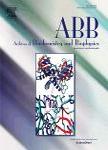版权所有:内蒙古大学图书馆 技术提供:维普资讯• 智图
内蒙古自治区呼和浩特市赛罕区大学西街235号 邮编: 010021

作者机构:TOHOKU UNIVSCH MEDDEPT BIOCHEMSENDAI 980JAPAN
出 版 物:《ARCHIVES OF BIOCHEMISTRY AND BIOPHYSICS》 (生物化学与生物物理学集刊)
年 卷 期:1976年第173卷第1期
页 面:71-81页
核心收录:
学科分类:0710[理学-生物学] 071010[理学-生物化学与分子生物学] 07[理学]
基 金:Foundation for the Promotion of Research on Medicinal Resources Ministry Education of Japan, (9780391) Tanabe Amino Acid Research Foundation
主 题:节杆菌属/药物作用 节杆菌属/代谢 细菌蛋白质类/分离和提纯 细菌蛋白质类/代谢 细菌蛋白质类/生理学 甘氨酸/代谢 动力学 脂类/分析 脂类/药理学
摘 要:The hydrogen carrier protein (H-protein) from Arthrobacter globiformis was found to contain one lipoic acid residue per molecule. In the glycine cleavage reaction, H-protein could be replaced by lipoic acid and in glycine synthesis, by dihydrolipoic acid. Lipoamide was less effective than lipoic acid in substituting for H-protein. In glycine synthesis with dihydrolipoic acid, even tetrahydrofolate and T-protein, an enzyme catalyzing the tetrahydrofolate-dependent step of the reaction, were not required, and the whole process of glycine synthesis could proceed in the presence of only one enzyme, P-protein, a pyridoxal phosphate-requiring enzyme. In the glycine decarboxylation reaction with lipoic acid, the decarboxylation product seemed to be bound to lipoic acid, possibly in the SCH2 NH2 form, which was extractable with benzene. The suspected intermediate compound could also be formed nonenzymically from dihydrolipoic acid, formaldehyde and ammonia, and glycine was obtained when the benzene extract containing the suspected intermediate compound was incubated with P-protein and NaHCO3 . Several lines of evidence suggest that a thiol group of dihydrolipoic acid reacts first with formaldehyde to form a hemimercaptal or mercaptal to which ammonia is subsequently fixed; the binding of ammonia, however, appears to be unstable. Based on observations with free lipoic acids, the sequence of the T-protein-dependent reaction steps in the enzymic, reversible glycine cleavage reaction is discussed.